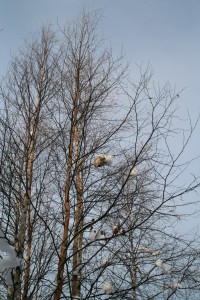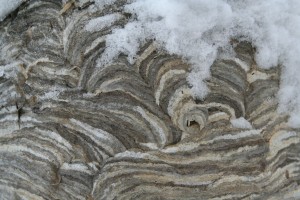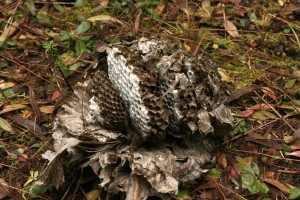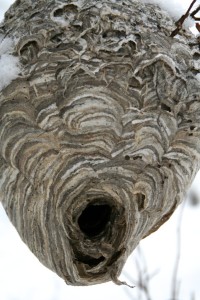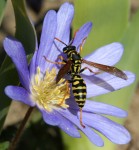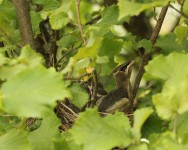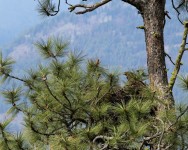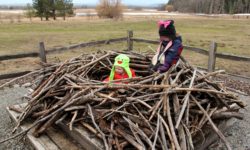As the yellow leaves of autumn drop from trees, they often reveal hidden treasures such as bird nests and less desirable wasp nests. The gray, papery football- to basketball-sized nests normally hidden by leaves are home to bald-faced hornets during the warmer months. Other paper wasps such as yellowjackets also create paper nests in varying shapes and sizes. Despite their name, bald-faced hornets are members of the yellowjacket family.
These visible nests in late fall and winter are the result of a summer’s worth of work by many hornets. The entire nest is built from wood fibers that each hornet has gathered, chewed and mixed with salvia in their mouth to form a soft wood pulp. The varying colors on the outside of the nest (called the envelope) result from different sources of wood fibers, which can include weathered and rotting wood, fence posts, dead plants, cardboard or newspaper.
The queen bee initiates nest building by adhering wood pulp to a structure, such as a tree branch, that will hold the nest, typically at least three feet off the ground. Then the queen starts building the nest with a horizontal layer of hexagonal cells on the inside and a papery, protective envelope on the outside to the size of a golf ball.
In those first cells, the queen will lay eggs that will become adult workers. Upon hatching and pupating into adults, the workers will take over the nest building and feeding the larvae while the queen solely lays more eggs in the cells they create. During the height of production a nest may hold up to 700 hornets.
The workers keep building the nest one mouthful at a time until it is roughly football or basketball size. They will create several horizontal layers of cells on the inside and a one-to-two inch multi-layered envelope on the outside while leaving a small, round hole near the bottom for an entrance.
Two sizes of hexagonal cells are created: small and large. The majority of the cells will be small and will be utilized up to three times during the summer to raise worker hornets. Starting in the fall, single-use larger cells will be constructed to raise the future queen hornets and the males (drones) that will mate with the newly hatched queens.
Mated queen hornets are the only ones to overwinter–the remainder die off when the temperature drops below freezing, including the reigning queen. Despite the thick outer envelope on the nest that keeps the hornets warm in the spring and fall and cool in the summer, it isn’t enough protection for a new queen in the winter. Instead, she will spend the winter in a crevice under tree bark, in a tree stump, behind house siding or in the eaves of a house. Come spring, the new queen will begin her own nest since bald-faced hornets do not reuse nests.
The abandoned nests don’t go unused–spiders and other insects will seek shelter in the nests during winter. However, insect-seeking birds easily hone in on the exposed hornet nests dangling in bare trees and will readily shred the nests looking for slumbering insects, which truly makes the nests hidden treasures.
As the yellow leaves of autumn drop from trees, they often reveal hidden treasures such as bird nests and less desirable wasp nests. The gray, papery football- to basketball-sized nests normally hidden by leaves are home to bald-faced hornets during the warmer months. Other paper wasps such as yellowjackets also create paper nests in varying shapes and sizes. Despite their name, bald-faced hornets are members of the yellowjacket family.

